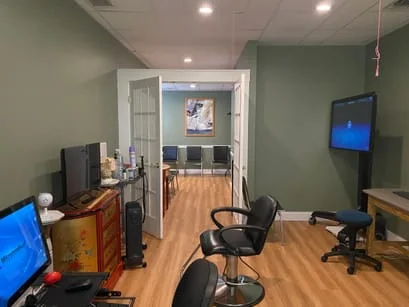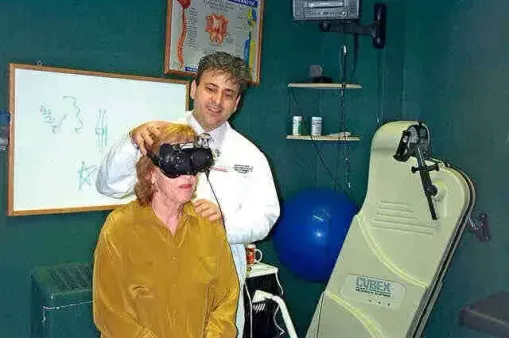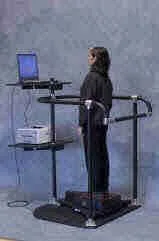Our vestibular laboratory is equipped with state of the art equipment for diagnosis and management of brain based disorders. Additionally, all procedures are performed by and interpreted by the doctor. Dr. Scopelliti has had years of additional post-doctoral neurological training in the performance and interpretation of these tests.
Video Nystagmography
A sophisticated tool used routinely in our laboratory for diagnosing vertigo, dizziness, dystonia, and balance disorders. Testing is quick, (about 20 minutes) and noninvasive/non-painful. Testing involves simply watching the movement of targets on a computer monitor while wearing goggles which are video infrared cameras. This allows us to accurately plot your eye movements against target movements for accuracy and errors. The results of this testing allow us to put together the most efficacious treatment plan possible.
Comprehensive Assessment of Postural Systems or CAPS™CAPS
A sophisticated tool used routinely in our laboratory for diagnosing vertigo symptoms, dizziness, dystonia, and imbalance. Testing takes less than a minute. Testing yields information regarding your risk of fall, direction of sway, limit of stability, and fatigue. This data is valuable for predicting fall risk, assessing current stability and determining the validity of treatments provided, as we can accurately measure if those treatments are making you better or making you worse.
Saccadometry
This technology uses lasers to accurately measures the latency, velocity and accuracy of saccades, which are the fast eye movements that take ones eyes away from an existing target to a novel target. Leftward and rightward saccades are controlled by the opposite hemispheres of the brain. As such, accurately measuring saccades allows a skilled examiner to evaluate asymmetries in function resultant to disfunction in the brain.
Saccades have been extensively studied in people with concussion/traumatic brain injury, neurodegenerative disorders such as Alzheimer’s and Parkinson’s diseases, and with a variety of neurologic conditions, such as ADHD.
the results of saccadometry testing use in conjunction with all other examination findings allows us to formulate the most specific brain-based rehabilitation plan possible, selectively targeting areas of brain dysfunction, thus providing the best results. Retesting allows us to a document improvement or the need to modify treatment.
Lastly, having saccadometry data on file is most helpful in the unfortunate event that you should suffer a traumatic brain injury in the future as this will allow us to know how your brain was functioning prior to that impact. It is most valuable to have that information as we know where you were at prior to the injury.
Video nystagmography
Patient Being Tested With VNG Goggles
Video nystagmography, (VNG), utilizes infrared technology to visualize eye movements in light or in dark. Using “virtual reality” type goggles and visual stimuli, recordings are made of eye movements which can later be interpreted to uncover causes of vertigo symptoms, dizziness, dystonia, ADD ADHD, and other brain based disorders discussed on this website.
This VNG test is noninvasive and non-painful. It takes less than 30 minutes to perform.
Actual VNG Testing Results
The information derived from this VNG test is invaluable in the diagnosis and management of persons with imbalance, vertigo symptoms, dizziness, ADD ADHD, as well as any type of brain based disorder.
This exciting new VNG technology has only been available in recent years. Our office is and has been a pioneer the use of VNG since its inception.
CAPS Posturography
CAPS Posturography Testing Risk of Fall
Consider that vertigo symptoms and dizziness are the number one reason for visiting a physician for persons age 65 and over, and about 11 million physician visits every year involve complaints of vertigo symptoms and dizziness or imbalance.
How Will My Balance Be Tested?
We use a product called CAPS™, an extremely sensitive force platform and specially designed software combined in a product that is years ahead of anything else available today (the CAPS™ is so unique, it has been awarded 2 separate U.S. patents, 1 for its design and 1 for the way it works).
The CAPS™ is so sensitive it can display a person’s heartbeat and respiration. In fact, it is so sensitive it even measure the forces caused by someone simply blowing their breath across its surface.
The extraordinary sensitivity of the CAPS™ allows us to measure the otherwise imperceptible, undetectable movements a person is always making when they are standing, even though that person appears to be standing absolutely still.
The CAPS™ can detect abnormal balance in a person in just 25 seconds, instantly comparing that person’s results to normative data that was established by testing hundreds of persons at a major medical school.
The CAPS™ then generates a report that quantifies the person’s balance, providing us with an objective balance score and warning us when the results are abnormal for the person’s age.





